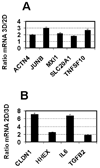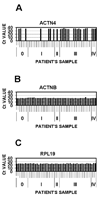Motility-related actinin alpha-4 is associated with advanced and metastatic ovarian carcinoma
- PMID: 18362906
- PMCID: PMC2849305
- DOI: 10.1038/labinvest.2008.25
Motility-related actinin alpha-4 is associated with advanced and metastatic ovarian carcinoma
Abstract
Advanced and metastatic ovarian cancer is a leading cause of death from gynecologic malignancies. A more detailed understanding of the factors controlling invasion and metastasis may lead to novel anti-metastatic therapies. To model cellular interactions that occur during intraperitoneal metastasis, comparative cDNA microarray analysis and confirmatory real-time reverse transcription PCR (RT-PCR) were employed to uncover changes in gene expression that may occur in late stage ovarian cancer in response to microenvironmental cues, particularly native three-dimensional collagen I. Gene expression in human ovarian carcinoma tissues was evaluated on the RNA and protein level using real-time RT-PCR and immunohistochemistry. Cell invasion and migration were evaluated in a collagen invasion assay and a scratch wound assay. Three-dimensional collagen I culture led to differential expression of several genes. The role of actinin alpha-4 (ACTN4), a cytoskeleton-associated protein implicated in the regulation of cell motility, was examined in detail. ACTN4 RNA and protein expression were associated with advanced and metastatic human ovarian carcinoma. This report demonstrates that a cytoskeletal-associated protein ACTN4 is upregulated by three-dimensional collagen culture conditions, leading to increased invasion and motility of ovarian cancer cells. Expression of ACTN4 in human ovarian tumors was found to be associated with advanced-stage disease and peritoneal metastases.
Figures






References
-
- Dupont NC, Berman ML. Surgical management of epithelial ovarian cancer: a review of the literature. Minerva Ginecologica. 2004;56(6):547–556. - PubMed
-
- Guppy AE, Nathan PD, Rustin GJ. Epithelial ovarian cancer: a review of current management. Clinical Oncology (Royal College of Radiologists) 2005;17(6):399–411. - PubMed
-
- Jemal A, Siegel R, Ward E, Murray T, Xu J, Smigal C, et al. Cancer statistics, 2006. CA: a Cancer Journal for Clinicians. 2006;56(2):106–130. - PubMed
-
- Runnebaum IB, Stickeler E. Epidemiological and molecular aspects of ovarian cancer risk. Journal of Cancer Research & Clinical Oncology. 2001;127(2):73–79. - PubMed
-
- Sankaranarayanan R, Ferlay J. Worldwide burden of gynaecological cancer: the size of the problem. Best Practice & Research in Clinical Obstetrics & Gynaecology. 2006;20(2):207–225. - PubMed
Publication types
MeSH terms
Substances
Grants and funding
LinkOut - more resources
Full Text Sources
Other Literature Sources
Medical
Miscellaneous

